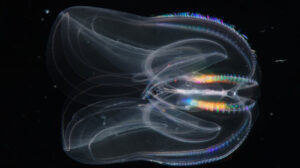All living things are born, grow, grow old and die. All? For a few, it turns out, aging is not a one-way street, as they can revert to their early form.
One marine organism, the ctenophore Mnemiopsis leidyi, which grows in the Atlantic Ocean but has established itself as an invasive species in parts of Europe and western Asia, has the ability to reverse the aging process when its survival is threatened.
According to a pre-publication of a study posted on BioRxiv by the non-profit research and education foundation Cold Spring Harbor laboratory, reverse growth is seen in just three species with the latest discovery involving the above-mentioned cnidosaur.
Specifically, an international research team found that the marine organism Mnemiopsis leidyi is capable of “turning back” time from a mature animal to an early stage.
Specifically, when the invertebrate cannot find food, or when it is injured, it returns to its larval form as only then do two tentacles develop, which it uses to catch its prey.
Scientists experimented with 65 individuals of the species, which were either left without food or had their tissues removed so that they could be slightly injured. They then observed that the sea creatures shrank significantly, like tiny blobs, but did not die. When they fed them again, they noticed that 13 of them had developed tentacles, an indication that they had reverted to the larval stage. In fact, not only did they regenerate the tissues that had been removed by the research team, but they began to reproduce.
The age reversal in the ctenophore “confirms that reversal may be more widespread than previously thought,” the experts explain in the study.
As Science reports, until recently biologists had only identified this ability in two animals: The so-called immortal jellyfish, Turritopsis dohrnii, which lives in the Mediterranean and in seas of Japan, which is capable of reverting to an earlier stage but reaching that of sexual maturity. Similar behaviour is observed in the granular echinococcus that causes echinococcosis, the well-known tapeworm.
The third species coming back at an early stage, then, is a “big surprise” to scientists, according to marine biologist and postdoctoral fellow at the University of Bergen in Norway, and author of the study, Joan J. Soto-Angel.
Speaking to Science, the expert explained that the individuals observed used their tentacles to catch phytoplankton, which they would not have access to as adults since this anatomical feature disappears in adulthood.
As Soto-Angel pointed out, with enough food the individuals regained their original size and grew back the tissues that had been removed, and even regained their ability to reproduce.
At the same time, it is clarified that the immortal jellyfish may “regenerate”, but the…Benjamin Button effect does not take place in the way observed in the case of Mnemiopsis leidyi, as with the reversal in time its cells lose their identity, so that “it is not exactly the same individual that comes back to the previous stage”, the marine biologist said.
This is not the case with ctenophores, since “it is clear that the exact same individual becomes younger, as if going back in time,” the marine biologist added.
Ask me anything
Explore related questions





